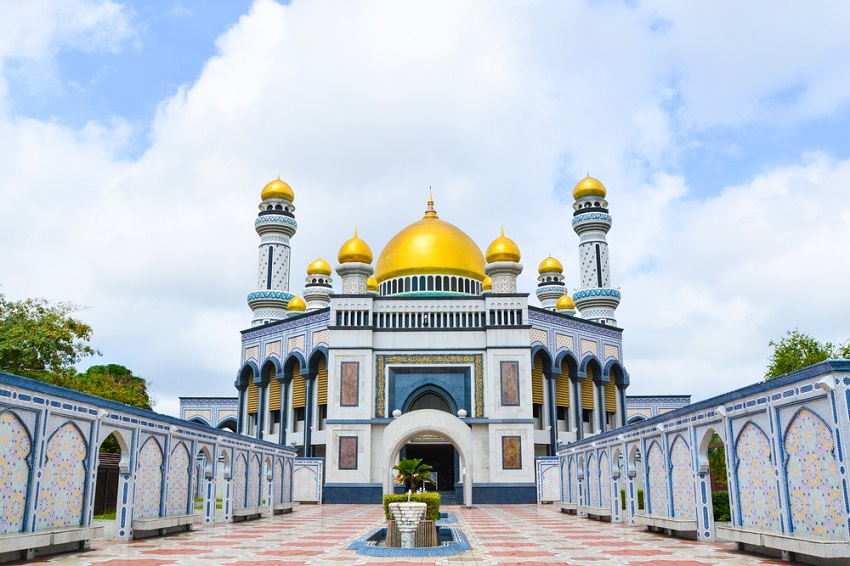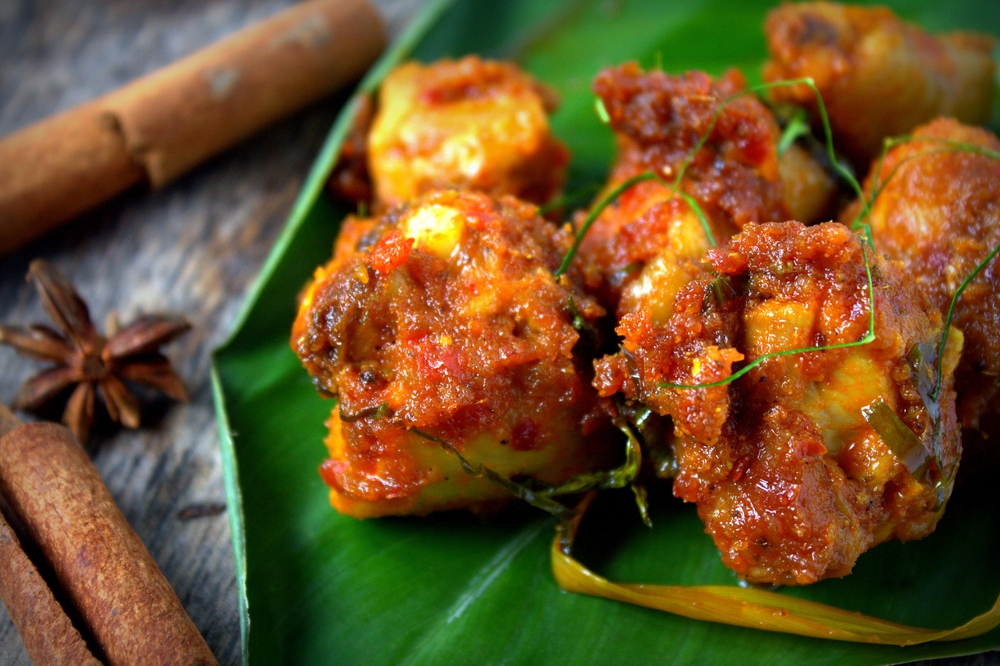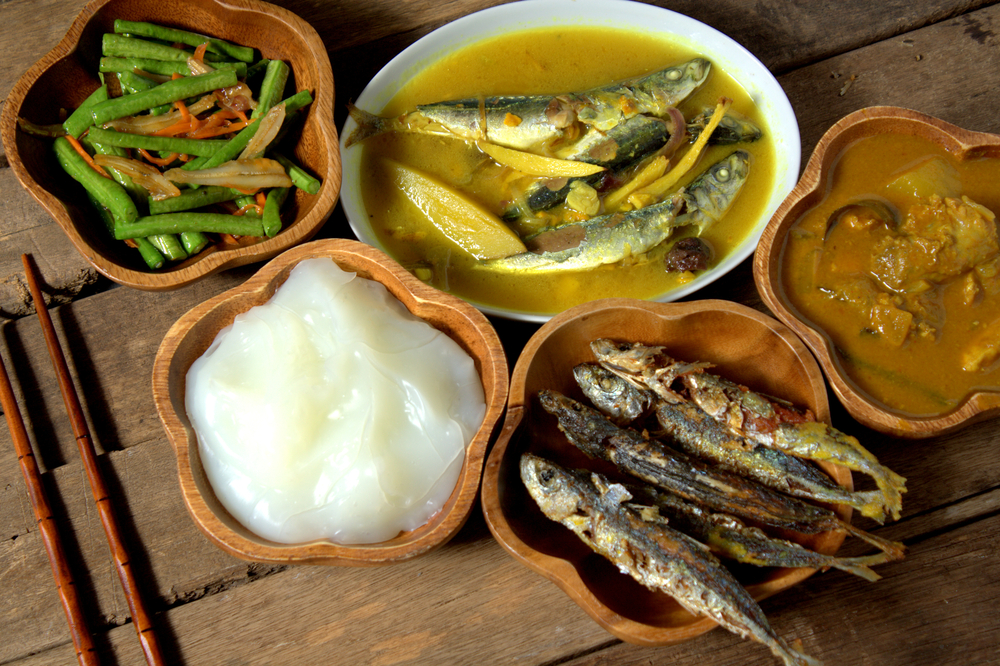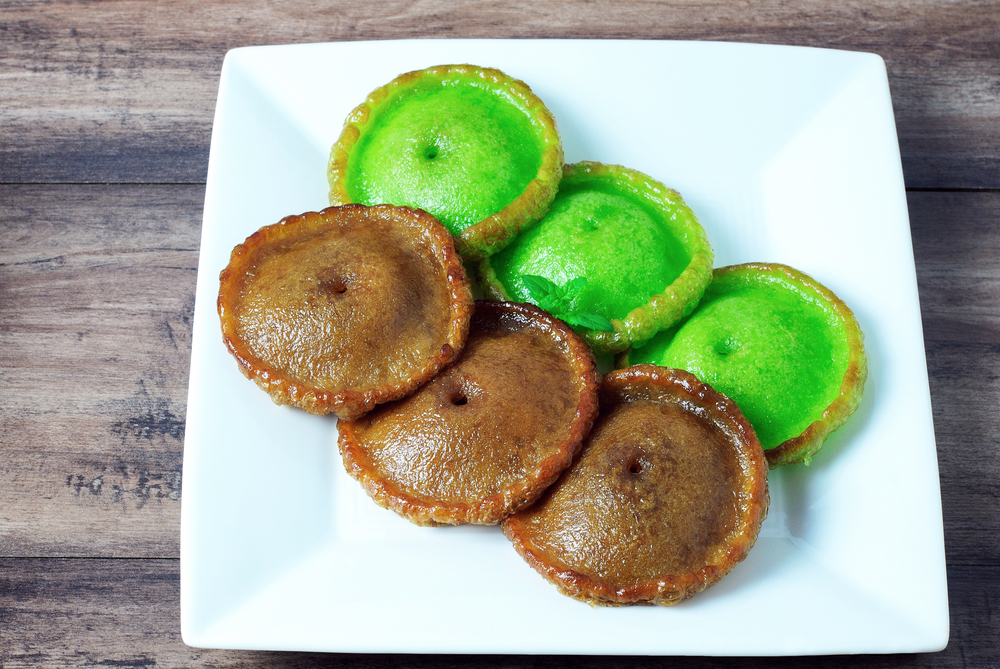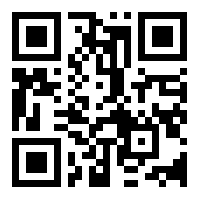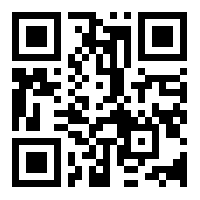Brunei - fact sheet
National flag
The flag of Brunei in a rectangle shape with a ratio of 1:2 has yellow as a background representing the Sultan. The black and white stripes lay across the flag. Black represents the ruler while an emblem placed on the center is the national emblem of Brunei.
In the past, Brunei had had the yellow flag representing the state. It was not until 1906 during which Brunei became Britain’s protectorate, black and white were added to the flag. In 1959, the national emblem was seen appearing along with the official declaration of Bruneian constitution.
National Emblem of Brunei
The national emblem of Brunei is inspired by and developed out of former royal emblem. It was declared official at a time when the constitution was enacted in 1959. The emblem features a flag (Bendara) with royal umbrella (Payung Ubor-Ubor) on top. These two components are considered regalia. Below lies the four wings (Sayap) conveying justice, tranquility, glory and peace. On both sides of the emblem, the upholding hands (Tangan) refer to the government that needs to take care of the nation.
Centered at the emblem, the upward-facing crescent refers to the official religion, Islam as a Malay message in Javi inscribed on the crescent “Sentiasa Berkhidmad Dengan Panduan Tuhan” meaning that “Always render service with God's guidance”. Under the crescent lies a cloth strip inscribing that “Negara Brunei Darussalam” that literally means Brunei, the Abode of Peace.
Location and area
Brunei is the second smallest country in Southeast Asia located on the north of Borneo Island. To its north, Brunei is bordered by South China Sea while sharing borders with Malaysia’s Sarawak on the east, west and south. Brunei covers the area of 5,765 square kilometers or equivalent to a size of Nakhon Phanom Province of Thailand.
Brunei’s topography can be understood by looking at two separate parts of the country. Most of the land covers the western side where it is separated by Malaysia. The eastern side covers ¼ of the country.Brunei’s coastal line runs 161 kilometers with the land borders reaching 266 kilometers. Every land border is shared with Malaysia.
Brunei is situated between north latitudes of 4 to 5 degree and east longitudes of 114 to115 degree, so its local time is 8 hours ahead of Standard Time (GMT+8) referring to 120 degree east longitude that determines the same time zone as Malaysia, Singapore, Central Indonesian Time and the Philippines, Brunei’s neighboring country.
Climate
Since Brunei’s location is tropical equatorial, the climate is inevitably tropical rainforest climate-AF according to Koppen climate classification. Brunei is rainy and humid with only two major seasons found, rainy and dry seasons. The average temperatures in dry season are 24-36 degree Celsius, while in rainy season are 20-28 degree Celsius.
The location of Brunei is made of island where it is rainy with average rainfall nearby the coastal lines of 2,500 millimeters and 4,000 millimeters in forest zone. The rainiest period is October to December, and the least rainy period is February to March.
Since the location allows heavy rainfalls in Brunei, most of the natural disasters occurring there appear to be floods and flash floods. In dry season, Brunei, sometimes, is affected by Indonesian wide fire smokes.
Topography
Brunei is consisted of coastal plains stretching to Eastern mountains and small hills scattering on West. The highest point of the country is Bukit Pagon, 1,850 meters above sea level. Belait River is the longest river in Brunei whose forest areas, mostly tropical rainforests and mangrove forests, covers 85% of the country.
Franz said Brunei’s topography could be understood in these three shapes: high land zone or high mountain range zone, hill zone and lower land or coastal plain. The mountain range zone is located in the southern part of the country (deep into the mainland). It, then, paves to river basins and sea shores. Many of Bruneian districts are located on river basins such as Belait River, Brunei River, Temburong River and Tutong River.
Politics and administration
Brunei is the sole country in Southeast Asia that remains absolute monarchy. This very regime these days is found in Islamic countries in Middle East such as Qatar and Saudi Arabia, the monarch or Sultan is the head of state and also the head of administration. Brunei is one of the four countries having the monarchy as the head of state in Southeast Asia just like Thailand, Malaysia and Cambodia.
History of Brunei shows that the administrative structure in the 15th century was divided into four key positions directly reporting to Sultan (ดลมนรรจน์ บากาและชัยวัฒน์ มีสัณฐาน, 2557: 84).
- Pengiran Bendahara – the head of administrative office
- Pengiran Tamagnon – the head of security and laws
- Pengiran Digantung – the head of treasury
- Pengiran Permanja – the head of traditions
In addition to these four key positions, the hierarchical structure included another 62 nobilities and 60 ministers responsible for lower to upper divisions. The position equivalent to today’s prime minister was Pehin Datu Perdana Menteri and there was also a religious post being appointed.
During that period of time, the effective Bruneian legal system was influenced by Malacca and Ajeh laws whose foundation had referred to Islamic law combined with native culture. The law has been enacted and evolved ever since.
It was not until Brunei became Britain’s protectorate when the law was more westernized. However, Islamic concepts and native culture have remained.
In 1959, the constitution was officially enacted in the reign of Sultan Omar Ali Saifuddien III, who co-drafted it along with his councils, while having British consultants. The constitution featured administrative structure divisions and rules and regulations for those taking up positions.
Philosophy of Bruneian Governance
Brunei’s administration is stipulated by MIB pillars that are Melayu, Islam and Berjaya (King) (ดลมนรรจน์ บากาและชัยวัฒน์ มีสัณฐาน, 2557: 92). Melayu means Brunei is the country of Melayu people, language and culture dominating the nation. Islam means Bruneian citizens are devout Islamic being unable to convert to other religions. They are obedient to the leader and religiously unified dedicating to good deeds as it is the religion God has given. King means Sultan who has divine right to rule over Brunei and its citizens. Sultan is the ruler, the religious leader, the leader of government officers, the cultural leader and the army leader of the country.
Head of state
Brunei has never experienced a discontinued monarchy. The first Sultan, the governor that first converted to Islam, was Sultan Muhammad Shah or Awang Alak Betatar. The current 29th Sultan is Sultan Hassanal Bolkiah.
His royal title is “Sultan Haji Hassanal Bolkiah Mu'izzaddin Waddaulah ibni Al-Marhum Sultan Haji Omar Ali Saifuddien Sa'adul Khairi Waddien”. He was born on 15th July 1946 in Seri Bandar Begawan or Brunei Town at that time. He is the oldest son of Sultan Omar Ali Saifuddien III, the 28th Sultan of Brunei, and finished high school from Victoria institution in Kuala Lumpur of Malaysia. Later, the sultan pursued his higher education at Royal Military Academy Sandhurst in England. He was appointed crown prince on 14th August 1961.
He succeeded his father becoming the 29th Sultan of Brunei on 4th October 1967. The coronation given by Queen Elizabeth II took place on 1st August 1968 as Brunei was Britain’s protectorate. On his personal account, the Sultan has 3 consorts and 12 children.Since Brunei is the absolute monarchy country, the Sultan is both Head of State and Head of Government.
Administration
Brunei applies a principle of checks and balance separating executive, legislative and judicial branches just like other countries. However, given that it is the absolute monarchy country, the Sultan is both Head of State and Head of Government. Brunei’s constitution also states that the Sultan is a chairperson and consultant to these five administrative bodies.
Privy Council takes a role of sultan consultant in governance and administration including the constitutional amendments and the Malay’s royal entitlements. The members of Privy Council are royals and high-ranking government officers.
Council of Succession is responsible for royal succession that needs to conform legislative acts of the constitution.
Religious Council known as Brunei Islamic Religious Council-BIRC is responsible for stipulating state policies and administration needing to conform to Islamism. The members are ministers, the chief of the Muslim, the Chief Justice of Sharia Court and sultan-appointed individuals.
Council of Minister consists of Prime Minister, Senior Ministers, the 12 ministers and deputy ministers. The 12 ministries of Brunei are Ministry of Finance, Ministry of Defense, Ministry of Foreign Affairs and Trade, Ministry of Education, Ministry of Religious Affairs, Ministry of Industry and Primary Resources, Ministry of Communication, Ministry of Health, Ministry of Development, Ministry of Culture, Youth and Sports and Ministry of Primary Resources and Tourism.
Bruneian cabinet has 22 members with Sultan Hassanal Bolkiah being Prime Minister and Minister of Ministry of Finance and Defense. The Crown Prince acts as Senior Minister being in charge of the 12 ministers and other 8 deputy ministers.
Legislative Council of Brunei was reestablished in 2004 after it had been halted in 1894. The council comprises of 36 members. President of Legislative Assembly is appointed by the Sultan himself, while its responsibilities include acting as a consultant to the government, checking, issuing laws and approving budgets. The members are cabinet, famous figures and community leaders as all are appointed by the Sultan.
A turbulent time when the idea of unifying with Malaysia cost all political parties to cease. However, in 1985, the political parties were allowed to make a comeback. Brunei National Democratic Party (BNDP) was established and followed by Brunei National United Party (BNUP). Though the political parties were allowed, strict supervisions by the Sultan took control. BNDP later was dissolved because its direction went against the Sultan government.
Judiciary
Brunei governs with two systems of the laws. The first system was founded by the British, and is a frame of reference to British law. It is enforced throughout Brunei. Minister of Ministry of Justice is in charge of enforcing the law, while hearing appeals is in charge of Supreme Court. The court system is divided into three levels: the trail court, appeal court and Supreme Court. In addition, Civil Court is responsible for financial disputes.
Another system is “Islamic Law” or known as “Sharia Law” enforcing on the Muslim with a separate court that judges by Islamic concepts. It can be divided into 4 divisions as follows (ดลมนรรจน์ บากาและชัยวัฒน์ มีสัณฐาน, 2557: 99-100).
- Mufti Division is responsible for interpreting and expounding given disputes.
- Qadi Division is responsible for hearing trials.
- Sharia Division is responsible for providing consults regarding Muslim business to the Sultan.
- Investigation Division is responsible for investigating, interrogating and arresting felons.
The Royal Brunei Armed Forces
The Royal Brunei Armed Forces was established on 31st May 1961. It had been developed out of Brunei Malay Regiment before being changed into Royal Brunei Malay Regiment depicting the king’s forces. Now it is The Royal Brunei Armed Forces (RBAF) being in charge of protecting and ensuring the nation’s security with the five-division structure. Royal Brunei Land Forces, Royal Brunei Navy, Royal Brunei Air Forces, Support Services, and Training Institute are the major five division. Yet, the Gurkha soldiers are station as guards protecting oil wells.
Local government
Brunei is a small country, in which the local government is divided into four districts (Daerah). Each district houses smaller units called Mukim and smallest units like villages (Kampong). These are the four districts:
Belait located on the westernmost point of Brunei is the largest district covering 2,724 square kilometers or half of the country. Its population, on the contrary, counts 60,744 heads. Kuala Belait is the capital city whose district name took from the Belait, the indigenous people living in that area.
Brunei and Muara is the most populous district with population of 279,924 or two-third of Bruneian population. Brunei and Muara is the smallest district covering 571 square kilometers. Seri Bandar Begawan is the capital city of both the district and country. Brunei and Muara has 18 Mukims in which 6 Mukims are floating villages.
Temburong is the district that is not connected to any land of other districts and pretty much isolated with Sarawak of Malaysia lying in between. Temburog covers the area of 1,304 square kilometers and has 8,852 populations, the smallest amount. Bangar is the capital city.
Tutong is the district lying between Belait and Brunei and Muara, covering 1,166 square kilometers with population of 43,852. Pekan Tutong is the capital city. The district has 8 Mukims.
International relations
International Organizations
Brunei became a member of Commonwealth on 1st January 1984, a member of ASEAN on 7th January 1984 and a member of United Nation on 21st September 1984. The nation also joins Organization of Islamic Cooperation (OIC), World Trade Organization (WTO) and Asia-Pacific Economic Cooperation (APEC), and has hosted many meetings.
International relations with neighboring countries
The relationship with the border-sharing country like Malaysia seems fine. However, what occurs to be a problem is the Limbang territorial dispute. Both sides settled the agreement of pulling off the exploration of petroleum and natural gas in that disputed area. They finally achieved the mutual agreement in March 2009 when Brunei had stopped claiming the land.
On the other hand, the relationship with Singapore is nothing but tight-knit as their economic systems support each other. Both are key trading partner, and Brunei decided to allow its currency to fluctuate by Singaporean currency.
Thailand established a diplomatic-consul relationship with Brunei on 1st January 1983. Nonetheless, as soon as Brunei declared independence, Thailand advanced to the ambassador level. Both have had exchanged formal visits afterwards.
Thailand and Brunei have enjoyed a good and smooth relation all along. Brunei imports consumption products from Thailand such as rice, ready-made garments, sugar and construction materials. On the other hand, Thailand imports crude oil from Brunei and approximate 15,000 Thai labors are working there. Most work in construction sector, but the numbers have started decreasing.
With England, Brunei always has had a tight-knit relationship because it was once Britain’s protectorate. Though Brunei gained independence, Britain has supported Bruneian forces by supplying weapons and providing military training. Britain managed to station the Gurkha soldiers as guards at oil wells.
Population and ethnic groups
Brunei houses population of 429,646 equivalent to population in Bueng Kan Province of Thailand. It comprises 65.7% of Malay, 10.3% of Chinese and 24% of the others. Malay is the official language while the other spoken languages are English and Chinese. Population structure is mostly made up by young dependants aged 25-54 taking up 46.9%. It is followed by child population aged 0-14 taking up 23.82%. The population growth increases by 1.62% with 17.32% of birth rate/ population of 1,000. The death rate is 3.52%/ population of 1,000. Immigration rate is 2.43%/ population of 1,000. Settlements in the city see 77.2%. The ratio of male and female population is fairly close (0.98 male/1 female).
Religions
Islam is the official religion. Sunni-Islamic make up 78.8% being followed by Christian 8.7% and others 12.5%.
Public holidays
Brunei’s public holidays are majorly involved with Islam referencing to Islamic calendar. The holidays include Muhammad Birthday, Israk Mikraj, First Day of Ramadhan, Hari Raya Aidil Fitri, Nuzul Al-Quran, Hari Raya Aidil Adha and Al-Hijra.
In addition, there are other public holidays involving the state business such as National Day (23 February), Royal Brunei Armed Forces Day (31 May), H.M the Sultan’s Birthday (15 July) and other holidays like New Year, Chinese New Year and Christmas.
National Anthem of Brunei
The national anthem of Brunei is inspired by the national anthem of England. It is “Allah Peliharakan Sultan” meaning Allah save the Sultan. The anthem was written by Pengiran Haji Mohamed Yusuf bin Pengiran Abdul Rahim, and was composed by Haji Awang Besar bin Sagap in 1947 when Brunei was Britain’s protectorate. However, it continued to be the national anthem of Brunei after the country had gained independence. The lyric is in Malay.
Bandar Seri Begawan
Bandar Seri Begawan was formerly known as Brunei Town. Brunei was historically considered as a city state before growing into kingdom and the now Brunei. History of Bandar Seri Begawan is history of Brunei. People around the world knew it as Brunei Town. It wasn’t until 1970 when Sultan Hassanal Bolkiah renamed it “Bandar Seri Begawan” after his father’s name in honor of his late Sultan. Seri Begawan in Sanskrit is “Sripawawan” while Bandar is a Malay language word derived from Arabic language meaning the port city.
Ethnic groups in Brunei
Malay
Malay, considered a dominant ethnic group in Brunei, is a major population. The Malay in Brunei are descendants of the Malay in Malay Peninsula and on Sumatra Island. It is believed they immigrated and settled here in ancient time as history of Brunei suggests the Malay had been long lived here ever since. The rulers of Brunei have been Malay.
The Malay in Brunei speak Malay, which is the official language. The national anthem is also sung in Malay. However, the spoken Malay language in Brunei is slightly different from the one in Malay Peninsula in terms of accent and wording. In Brunei, there are three different spoken accents. The Brunei-Malay accent is a standard spoken language while the Gerda accent is spoken in rural areas. Kampong Ayer is spoken in the unique floating communities.
The Malay in Brunei are Islamic just like the Malay in any other parts of the world. Islam had become more influential before taking the place of Brahman-Hinduism. It was the religious belief that foreign traders introduced, while, historically, the Malay in Brunei had been long Islamic since the ancient time.
Chinese
The Chinese make up 10% of the population. The Bruneian had come into contact with Chinese long time ago before they regularly started immigrating to Brunei, where the Chinese immigrants mostly are the Hokkien from Fujian of China. Some are from Hakka and Guangdong.
The Chinese, being famous for their trading and merchant skills and like any Chinese living in Southeast Asia, play a vital role in contributing to Brunei’s economics, in which shops and shopping malls are run by them.
Iban
Iban is one the branches of Dayak, the majority of population on Borneo Island. The Dayak living on the northern part Borneo Island in Sarawak and Brunei’s territories, are known as Dayak Laut or Sea Dayak. They are the Iban people.
The Iban have resided on this land for so long. Their religious beliefs include Christianity and Animism. The housing architecture of the Iban is so unique it is called ‘long house’ built with a single large room in which many families live together. In the past, when the Iban won a fight, they would behead enemies and bring the heads back home for decoration.
Culture of Brunei
The mainstream culture of Brunei is a culture of the Malay. Islamic influences also help shape culture of Brunei as well. Some Bruneian are living in modern houses. On the other hand, some are living in floating villages built on water. It has been a unique architecture of Brunei since the past, and is called “Kampong Ayer” meaning “floating village”. Now its sanitary is modernized as well as more accessible transportation.
Other cultures regarding ways of life from birth, marriage to death are all conducted in a way that conform to Islamic law along with Malay culture. In terms of food culture, the Muslim strictly eat Halal food certified by the government-appointed committees. The ingredients can be found in local areas, or most of which are imported from the neighboring countries.
The Bruneian costume is similar to the Malay in anywhere else. They prefer wearing Kebayaya Panjang, a waist-long shirt with Hijab while the costume for men features a Malay shirt, a black hat, trousers and a sarong. Men usually wear sarongs when relaxing at home. The dress codes for the Bruneian must not violate Islamic law and they do not prefer wearing yellow, the royal color.
Education
Brunei recognizes the essentials of education just like any other countries. The government provided 12 years of compulsory education starting from pre-primary school, 7 years of primary school, and 3 years of secondary school to high school or 2 years of vocational school. The education provided needs to conform to the governance philosophy that is Malay, Islamic Law and the Sultan. This principle also applies to any private schools. The government waives tuition fees for the compulsory education. Brunei, at the present, teaches Malay, English and Chinese languages serving different ethnic groups.
In addition, religious-teaching schools are another alternative. Those preferring to take courses there need to study at normal school in the morning before continuing the religious-teaching schools in the afternoon. What makes it different from normal schools is these provide religious and Arabic lessons.
Brunei has only one university for higher education. Universiti Brunei Darussalam was founded in 1985. The government encourages pursuing higher education abroad.
Economics
In spite of not being one of the world’s leading countries, Brunei’s economics is fairly good due to its small population resulting in one of the highest GNP countries in the world. (ที่มาhttp://www.imf.org/external/pubs/ft/weo/2015/02/weodata/index.aspx)
The national income derives from exporting oil and natural gas making up approximately 80-90% of exported products (ดลมนรรจน์ บากาและชัยวัฒน์ มีสัณฐาน, 2557: 191). However, Brunei is a small country and does not contribute any technological advances. It imports consumption goods and technological products, yet Brunei does not suffer any loss.
Realizing one day oil will be run out, the government established Economic Development and Cooperation in order to develop and improve the economics. It is relying less on income oil has generated and is supporting other industries. Brunei has started improving export clothing, cement and construction material industries. Brunei Investment Agency is also taking income from exporting oil and investing in leading-country bonds. (ดลมนรรจน์ บากาและชัยวัฒน์ มีสัณฐาน, 2557: 193)
Brunei has its own currency. BND and allows fluctuation in prices with Singaporean currency. Treasury Board, Currency Board and Brunei Investment Agency are in charge of any transaction because Brunei does not have any reverse banks.
Transportation
Brunei has standard-verified transportations. Since oil price is cheaper there, people prefer owning many cars. Public transportation is by bus, yet the service and accessibility is limited. Taxi is another option for privately-hired transportation.
Brunei has three government-run cargo ports located in Bandar Seri Begawan, Muara and Belait, while other three private ports are located in Seria, Mulaut and Tangyongseurirang. Muara is the main largest port in the country.
Royal Brunei Airlines is the national airlines providing routes to major cities like Bangkok, Singapore, Hong Kong, Melbourne, Dubai and London. (ที่มา: https://www.flyroyalbrunei.com/en/thailand/plan/route-map/) The national airlines was founded in 1974.
Tourism
Having realized that its most-wanted natural resources generating numerous income will be out one day, Brunei is relying on other sources of income. One of the industries that the government is encouraging is tourism in aspects of culture, sports and nature. However, Brunei is not a popular destination with only 200,000 visitors per annum.
Most of the tourist attractions are in Bandar Seri Begawan and none of which has so far registered as World Heritage sites. Here are some interesting tourist attractions.
Omar Ali Saifuddin Mosque is considered the most beautiful mosque in Brunei with its unique gilded dome. The building was built in 1958 with Italian marbles under the reign of Sultan Omar Ali Saifuddin.
Floating Village is the most unique characteristic of Brunei. It earns reputation for Brunei. The village itself is a river in Bandar Seri Begawan where people build their floating houses depicting the Bruneian settlement in the past. Visitors travel by boat to see the village.
In addition to these tourist attractions, leisure hotels and resorts are available as well as beaches, tropical rainforests for educational field trip. Theme parks are among those too.
Public Health
Brunei recognizes the importance of providing public health. The government spends 2.5% of the GNP with it and promotes a policy “Health for All” (ดลมนรรจน์ บากาและชัยวัฒน์ มีสัณฐาน, 2557: 240) in hopes to service every citizen regardless of their races. Public health of Brunei is free of charges.
As a result, the average life expectancy of a Bruneian is 77 years old with 1.44 doctor per 1,000 people and 2.8hospital beds per 1,000 people. Raja Isteri Pengiran Anak Saleha Hospital (RIPAS Hospital), the largest hospital in Brunei, has 550 beds.
Bibliography
Central Intelligent Agency [Homepage on the Internet]. The World Factbook: Brunei. 2015; [Cited 2015 Oct 25]. Available from: https://www.cia.gov/library/publications/the-world-factbook/geos/bx.html
Brunei Tourism [Homepage on the Internet]. Brunei. [Cited 2015 Oct 25]. Available from: http://www.bruneitourism.travel/index.php
The Government of Brunei Darussalam [Homepage on the Internet]. History of Brunei. [Cited 2015 Oct 25]. Available from: http://www.history-centre.gov.bn
Nusantara Studies Center [Homepage on the Internet]. ชนพื้นเมืองในรัฐซาราวัค ประเทศมาเลเซีย. [Cited 2015 Oct 25]. Available from: http://nikrakib.blogspot.com /2009/12/blog-post_115.html
The Government of Brunei Darussalam [Homepage on the Internet]. Flag of Brunei. [Cited 2015 Oct 25]. Available from: https://web.archive.org/web/19990427213829/http://www.brunei.gov.bn/about_brunei/flag.htm
Columbus Travel Media Ltd. [Homepage on the Internet]. Brunei Weather, Climate and Geography. [Cited 2015 Oct 25]. Available from: http://www.worldtravelguide.net/brunei/weather-climate-geography
